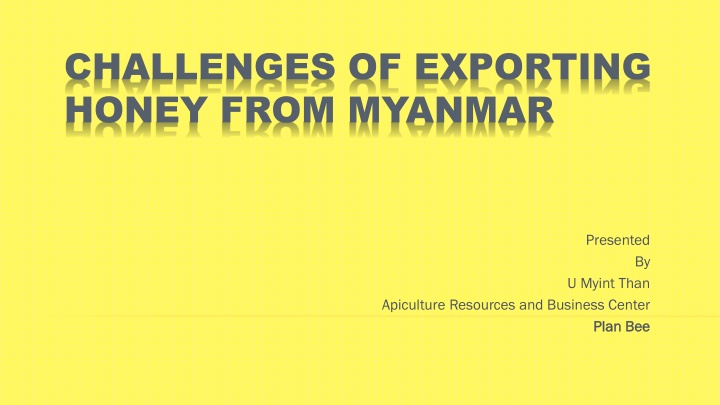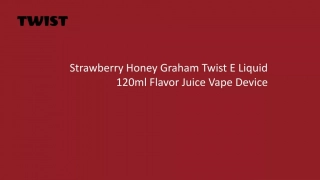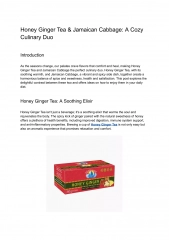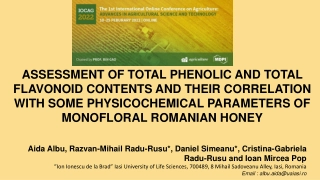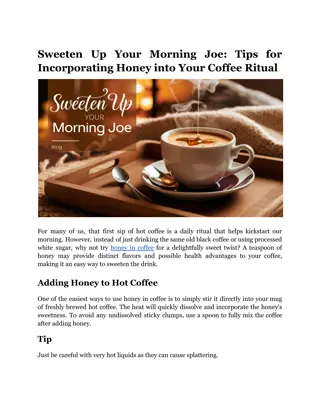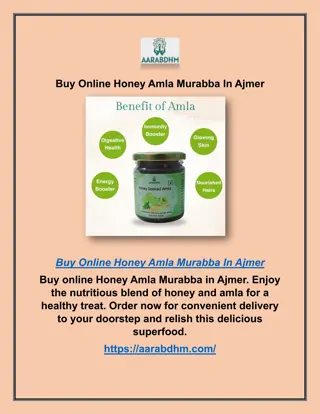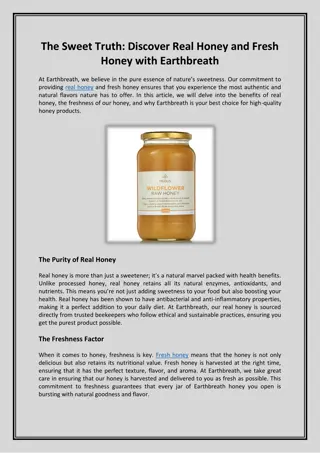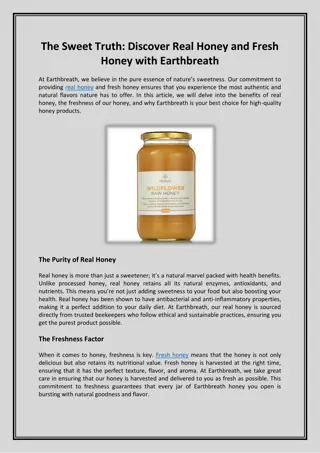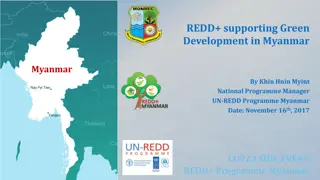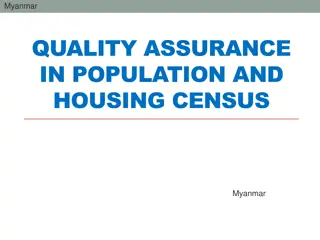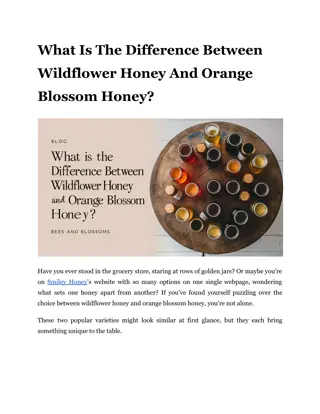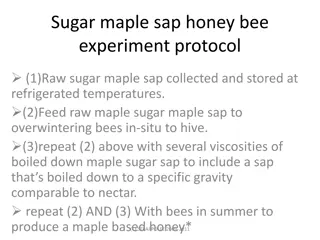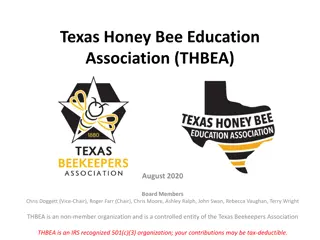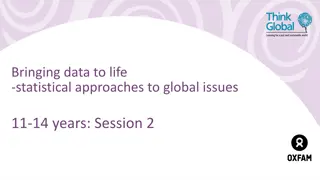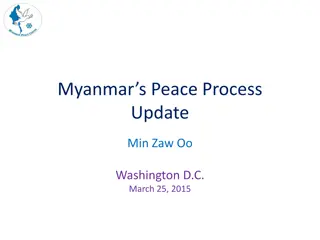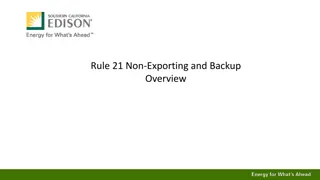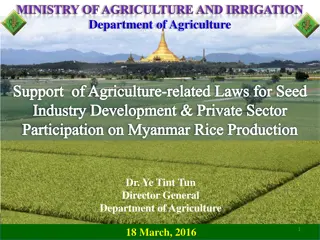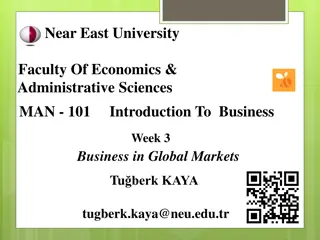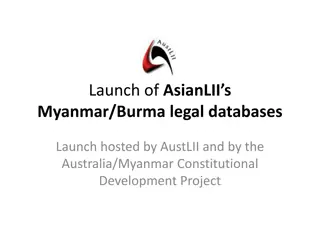Challenges of Exporting Honey from Myanmar: Insights from U. Myint Than
Modern beekeeping in Myanmar started under British colonial rule, and has since seen advancements with support from international organizations and experts. The country has a growing number of registered commercial beekeepers producing significant amounts of honey annually. Despite facing challenges in accessing developed markets due to sanctions, there is potential for expansion and export to the global market, with efforts underway to enhance beekeeping practices and increase production capacity.
Download Presentation

Please find below an Image/Link to download the presentation.
The content on the website is provided AS IS for your information and personal use only. It may not be sold, licensed, or shared on other websites without obtaining consent from the author.If you encounter any issues during the download, it is possible that the publisher has removed the file from their server.
You are allowed to download the files provided on this website for personal or commercial use, subject to the condition that they are used lawfully. All files are the property of their respective owners.
The content on the website is provided AS IS for your information and personal use only. It may not be sold, licensed, or shared on other websites without obtaining consent from the author.
E N D
Presentation Transcript
CHALLENGES OF EXPORTING HONEY FROM MYANMAR Presented By U Myint Than Apiculture Resources and Business Center Plan Bee Plan Bee
PRESENTATION IS DIVIDED IN FOUR SECTIONS; PRESENTATION IS DIVIDED IN FOUR SECTIONS; 1. A BRIEF BACKGROUND OF BEEKEEPING IN MYANMAR 1. A BRIEF BACKGROUND OF BEEKEEPING IN MYANMAR 2. ANALYSIS OF HONEY MARKET IN THE WORLD 2. ANALYSIS OF HONEY MARKET IN THE WORLD 3. THE CHALLENGES IN ACCESSING THE DEVELOPED MARKETS IN THE WORL 3. THE CHALLENGES IN ACCESSING THE DEVELOPED MARKETS IN THE WORLD D 4. HOW WE MAY NEED TO PREPARE FOR THE CHALLENGES AND TURN IT TO 4. HOW WE MAY NEED TO PREPARE FOR THE CHALLENGES AND TURN IT TO OPPORTUNITIES OPPORTUNITIES
Background Background Modern beekeeping was introduced in Myanmar (then Burma) under the British colonial rule around the 1920s. The British brought the apis mellifera bee species from UK. In the early 1980s with the help of FAO and United States The world known bee scientist, the late, Dr. Roger Morse of Cornell University together with Dr. Zamarlicki of USA started the beekeeping project in Myanmar. Mr. Shaike Stern from Israel was also sent to Myanmar to support the trainings in the 1980s. The project trained dozens of government employees and fresh university graduates in modern beekeeping. Myanmar government sent newly trained beekeepers to United States, United Kingdom, Australia and Israel for further trainings. European bees are started introduced in Myanmar by then. 2012, Tag International Development together with Mashav, Israel international cooperation agency, contacted Myanmar government and explained their intention to train the rural population in modern techniques of beekeeping for the increase of household incomes in the target area and to create new livelihood. Mr. Shaike Stern came to Myanmar again as an expert in the Plan Bee project. The government agreed the project and Livelihood and Food Security Fund (LIFT) agreed to fund it. Then, Tag together with Apiculture, Livestock Breeding and Veterinary Department as associate partners and local NGOs Parami Development Network (PDN) and Danu Literature, Culture and Regional Development Associations as implementation partners started the Plan Bee project in early 2013 till now.
Present status of beekeeping and honey production in Present status of beekeeping and honey production in Myanmar Myanmar Myanmar has 893 registered commercial beekeepers and is producing about 4500 metric tons of honey a year. Out of the total produced quantity, about 3500 metric tons, are exported only in the region due to the economic sanctions imposed on the country. Many apiculture and environment experts visiting the country confirmed that they saw a good potential for increasing the present status of beekeeping. People are increasing their capacity for beekeeping so as to increase the number of colonies they are keeping. With the present situation and trend, the production of Myanmar honey would be doubled within a decade. Myanmar beekeepers are looking forward to exporting to the world market.
Beekeepers and Bee Colonies in Myanmar (2015 Beekeepers and Bee Colonies in Myanmar (2015) State/Division Reg. beekeepers Kachin 38 Sagaing 284 Mandalay 284 Naypyidaw 52 Shan 69 Kayah 13 Kayin 12 Bago 57 Magwe 76 Yangon 8 Srl No. of colonies 4310 39440 54518 4605 9545 460 700 5950 8485 1655 Remarks 1 2 3 4 5 6 7 8 9 10 Total 893 129668 (Source: DoA)
Product Description Product Description Specific definition of the product: According to the Codex Alimentarius (CA) Specific definition of the product: According to the Codex Alimentarius (CA) from World Health Organization, honey is defined as the natural sweet substance, produced by honey bees from the nectar of plants or from secretions of living parts of plants or excretions of plant sucking insects on the living parts, which the bee collect, transform by combining with specific substances of their own, deposit, hydrate, store and leave in the honey combs to ripen and mature. Blossom Honey or Nectar Honey Blossom Honey or Nectar Honey; the honey which bees create from the nectars of the plants. Honeydew Honey Honeydew Honey; the honey which bees create mainly from sap secreted by insects (Hemiptera) from the living parts of the plants or secretions of living parts of the plants. HS Code of natural honey: 040900 HS Code of natural honey: 040900
TREND IN WORLDWIDE HONEY PRODUCTION TREND IN WORLDWIDE HONEY PRODUCTION
TRENDS IN BEEHIVES NUMBER ACROSS CONTINENTS TRENDS IN BEEHIVES NUMBER ACROSS CONTINENTS
World World Top available honey, with estimated value of 1.12 billion dollars. United States was the world s second largest honey importer, importing 16% of the market share at an estimated value of 518 million dollars. The France was third, United Kingdom was fourth, and Japan was the fifth. Below is a list of the top ten countries importing honey in the world. (Source: International Trade Centre, www.trademap.org) Top Honey Honey Importers Importers EU(28) was the number one honey importer in 2014. They imported almost a quarter of the Unit: US$ 1000 Unit: US$ 1000 Importers Importers Imported value in 2012 Imported value in 2012 Imported value in 2013 Imported value in 2013 Imported value in 2014 Imported value in 2014 EU(28) EU(28) 871,631 1,032,995 1,121,548 USA USA 429,983 498742 518,636 Germany Germany 281,732 325,387 307,610 France France 93,712 113,479 152491 United Kingdom United Kingdom 113,777 126,115 129,186 Japan Japan 105,373 115,956 120,157 Belgium Belgium Saudi Arabia Saudi Arabia Spain Spain Poland Poland Netherland Netherland Austria Austria 55,820 51,908 48,292 35,060 39,321 63,410 61,606 53,631 48,198 46,443 77,093 66,150 60,776 53,778 48,023 33,130 35,526 34,398
WORLD TOP HONEY EXPORTERS WORLD TOP HONEY EXPORTERS (SOURCE: INTERNATIONAL TRADE CENTRE, WWW.TRADEMAP.ORG) US$ 1000 US$ 1000 Exported value in Exported value in 2011 2011 Exported value Exported value in 2012 in 2012 Exported value Exported value in 2013 in 2013 Exported value in Exported value in 2014 2014 Exported value in Exported value in 2015 2015 Exporters Exporters World World 1,700,086 1,767,513 2,076,628 2,333,213 China China 201,375 215,051 246,550 260,263 Argentina Argentina 223,553 215,147 212,637 204,438 New Zealand New Zealand 87,089 103,892 140,174 168,191 Germany Germany 120,716 129,527 140,444 151,120 Mexico Mexico 90,359 101,497 112,352 147,037 Viet Nam Viet Nam 67,141 58,131 89,966 132,974 Spain Spain 79,184 79,843 91,483 120,428 Brazil Brazil 70,869 52,348 54,124 98,576 81,720 Ukraine Ukraine 27,821 31,113 52,972 93,198 Hungary Hungary 60,117 63,501 90,467 92,066
Market Market access access requirements requirements in in EU EU The The right honey to Europe, producers must comply with legally binding requirements. All European food legislation is based on the principles of traceability, risk analysis and precautionary measures. EU legislation prohibits the import of honey from countries outside the third right to to become become an an exporter exporter of of animal animal origin origin products products to to EU EU When exporting the third country country list list . Since most honey is used as food, EU legislation on food applies to all honey imported into the EU. The basis for food legislation is laid down in the EU General Food Law (Regulation (EC) 178/2002), which also defines responsibilities and requirements for food business operators supplying food to the EU. Business operators such as honey processors are required by law to comply with the EU legislation on hygiene of foodstuffs (Regulation (EC) 852/2004). The General Hygiene legislation requires a clean production environment and personnel trained in the hygienic handling of honey. EU legislation requires that products with food safety problems should be taken off the market and consumers should be informed.
Market Market access access requirements requirements (cont (cont. .) ) The General Food Law requires EU food business operators, such as honey importers, to be able to identify each supplier of every batch of honey. Directive (EC) 110/2001 sets European requirements concerning honey quality standards and labelling. Regulation (EC) 470/2009, in conjunction with the annexes of Regulation (EC) 2377/90, establishes maximum residue levels (MRLs) for the use of authorized veterinary drugs, such as antibiotics, applied to honey bees. The use of certain pesticides in agriculture is leading to massive decline in bee colonies, also known as Colony Collapse Disorder (CCD). The EU has established strict guidelines concerning foods containing GMOs. A ruling issued by the European Court of Justice in September 2011 stipulated that honey with traces of pollen from genetically modified crops needed special authorization and labeling, before it could be sold in Europe.
According to REGULATION (EC) No 178/2002 OF THE EUROPEAN PARLIAMENT AND OF THE COUNCIL REGULATION (EC) No 178/2002 OF THE EUROPEAN PARLIAMENT AND OF THE COUNCIL Food shall not include: (1) feed; (2) live animals unless they are prepared for placing on the market for human consumption; (3) plants prior to harvesting; (4) medicinal products within the meaning of Council Directives 65/65/EEC (1) and 92/73/EEC (2); (5) cosmetics within the meaning of Council Directive 76/768/EEC (3); (6) tobacco and tobacco products within the meaning of Council Directive 89/622/EEC (4); (7) narcotic or psychotropic substances within the meaning of the United Nations Single Convention on Narcotic Drugs,1961, and the United Nations Convention on Psychotropic Substances, 1971; (8) residues and contaminants.
REGULATION (EC) No 852/2004 OF THE EUROPEAN PARLIAMENT AND OF THE COUNCIL REGULATION (EC) No 852/2004 OF THE EUROPEAN PARLIAMENT AND OF THE COUNCIL lays down general rules for food importers and business operators on the hygiene of foodstuffs, taking particular account of the following principles: (a) primary responsibility for food safety rests with the food business operator; (b) it is necessary to ensure food safety throughout the food chain, starting with primary production; (c) it is important, for food that cannot be stored safely at ambient temperatures, particularly frozen food, to maintain the cold chain; (d) general implementation of procedures based on the HACCP principles, together with the application of good hygiene practice, should reinforce food business operators responsibility; (e) guides to good practice are a valuable instrument to aid food business operators at all levels of the food chain with compliance with food hygiene rules and with the application of the HACCP principles; (f) it is necessary to establish microbiological criteria and temperature control requirements based on a scientific risk assessment; (g) it is necessary to ensure that imported foods are of at least the same hygiene standard as food produced in the Community, or are of an equivalent standard.
GOOD BEEKEEPING PRACTICE GOOD BEEKEEPING PRACTICE Who is concerned? The large majority of beekeepers who are regarded as primary producers. What is concerned? Work at the apiary, Harvesting, transport, and packaging of Honey Direct selling of honey, storage.
Codex General Principles of Food Hygiene Codex General Principles of Food Hygiene Code adopted in 1969, revised in 1979, 1985, and 1997 Definitions: Definitions: Food hygiene Food hygiene - all conditions and measures necessary to ensure the safety and suitability of food at all stages of the food chain HACCP HACCP - a system which identifies, evaluates and controls hazards which are significant for food safety
GOOD MANUFACTURING PRACTICE (IN PROCESSING OF BEE PRODUCTS) GOOD MANUFACTURING PRACTICE (IN PROCESSING OF BEE PRODUCTS) Design, construction and maintenance of buildings, facility and equipment. Purpose and scope Sources of hazards Mandatory requirements Procedures Records Potable water Cleaning and sanitation Personal competency, health and hygiene Control of chemicals Pest control Packaging materials (specification, storage and handling) 1. 2. 3. 4. 5. 6. 7.
GOOD MANUFACTURING PRACTICE (IN PROCESSING OF BEE PRODUCTS) GOOD MANUFACTURING PRACTICE (IN PROCESSING OF BEE PRODUCTS) ---- ----- - CONT. CONT. Receipt and processing of honey and dried pollen Procedures for the receipt of honey, pollen and other bee products Procedures for the processing of honey Procedures for the processing of pollen Traceability and inventory control Monitoring Records Document control and record keeping 10. Recall 11. Operator verification and other operational requirements 8. 9.
Hazard Analysis and Critical Control Point (HACCP) List hazards associated with each process step (Principle #1) Apply HACCP decision tree to determine CCP s (Principle #2) Establish critical limits (Principle #3) Establish monitoring procedures (Principle #4) Establish deviation procedures (Principle #5) Establish verification procedures (Principle #6) Establish record keeping/documentation for principles 1 - 6 (Principle #7)
GHP and HACCP GHP and HACCP HACCP systems Prerequisite to establishing HACCP programme Programme of GMP Based on Codex General Principles of Food Hygiene (documented, verified and audited)
Market access requirements in USA Public Health Security and Bioterrorism Preparedness and Public Health Security and Bioterrorism Preparedness and Response Act of 2002 of 2002 (The Bioterrorism Act of 2002) became effective on December 12, 2003 Response Act FDA Requirements An importer of honey need to register at US FDA The Processing plant which the importer used need to register at US FDA
At the Apiary At the Apiary Name, ID card of beekeeper Contract of honey delivery with collector or exporter Registration number of beekeepers with authorized office Number of colony, quantity of honey output List of employees Training and Health certificates Inspection records if any
At the Apiary At the Apiary -- (cont.) Beekeeping diary in previous months or year Surround environment: Water, Air, cattle sheds Materials to make hive, extractor, smoker, container and their clean situations. (Procedure of use, clean up and maintenance) Procedure of extracting honey Supplements: Ingredients and manufacturers Method applying to treat bee disease and mites (Procedure of storage at apiary) Transport Name of honey receiver and documents GHP is recommended
Processing plant Processing plant FDA Registration No. Address of office and processing stations Internal Rules List of employees and assigning responsibilities Their certificates of training and health Procedures of receiving, sampling, testing, processing, hygiene, packing, delivery GHP, GPP, GMP are required Documents on origins of raw honey, containers
